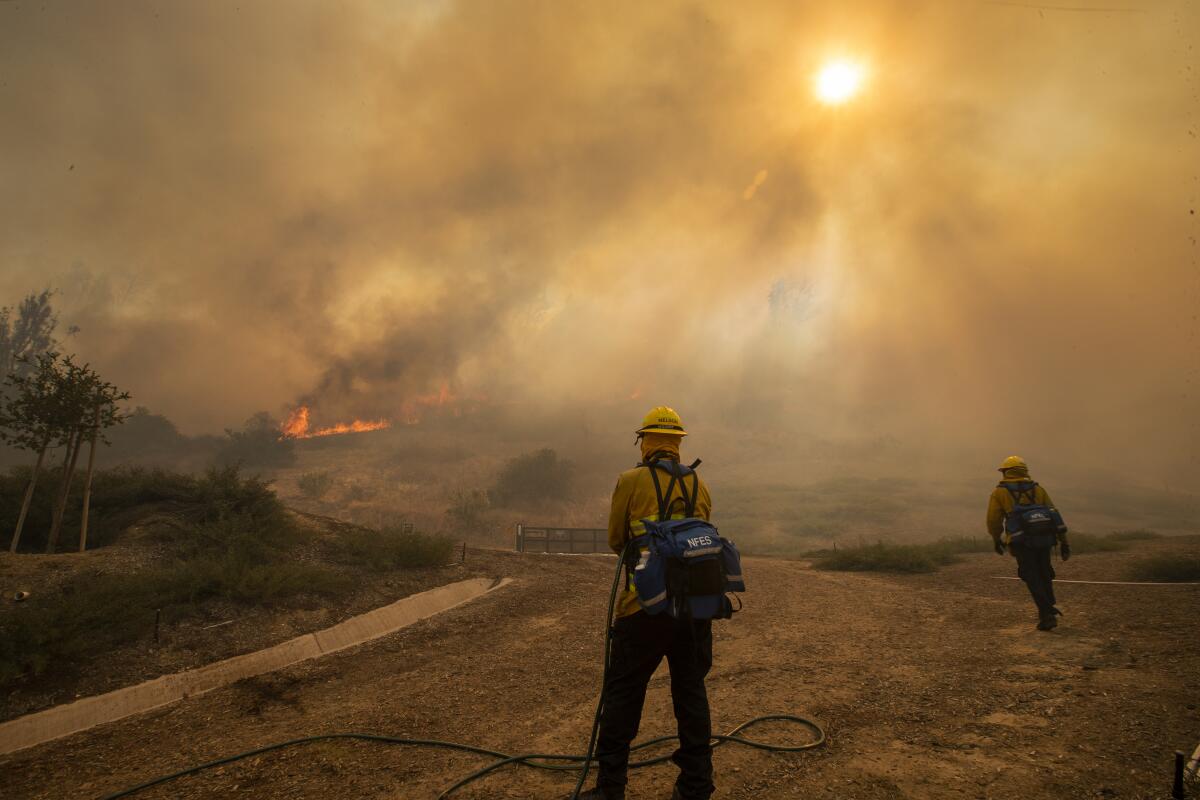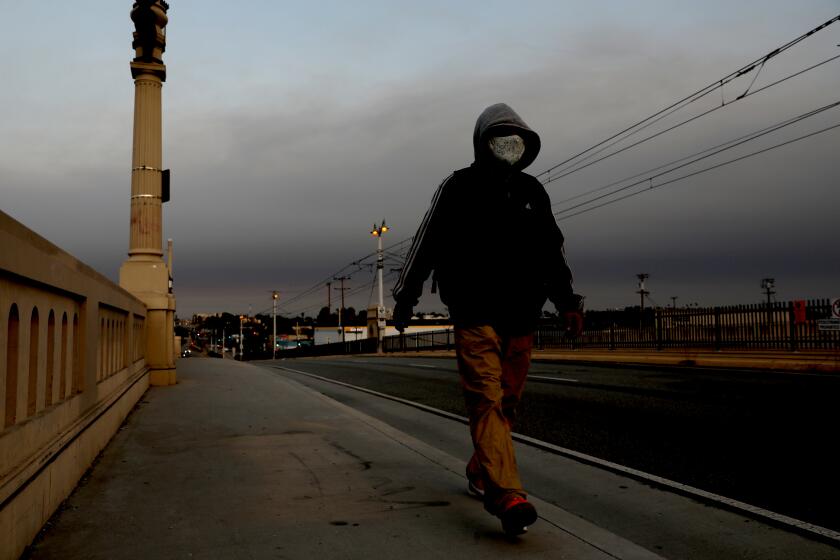Op-Ed: The West is choking on smoke. When will it penetrate the nation’s consciousness?

- Share via
Usually the pictures are of the fire itself. Flames are stunning and visceral, and draw the eye irresistibly. They also occur — even when engulfing the forest canopy — at a roughly human scale. This season’s outbreaks have served up a carnival of such images. But the more enduring visual of the year’s successive conflagrations, including Monday’s Silverado fire in Irvine, is likely to be smoke.
Smoke in roiling vortexes. Smoke in towering plumes, capped by pyrocumulus clouds punching through the troposphere. Smoke blanketing regions in biblical darkness. Smoke-like debris flows dense with embers rushing over the countryside. The only comparable images might be of the dust storms that roiled the Great Plains in the 1930s. The mega-fires blowing through the West today may prove as influential as the Dust Bowl then.
Even fire science has taken notice. Ecology has begun to scrutinize smoke as it has fire, as an inevitable ecological presence, one that can stimulate the flowering of some plants and fumigate away pests. Recently, it has spawned a new subfield, aeropyrobiology, committed to studying how fire-powered plumes can waft microorganisms about the landscape, an atmospheric analogue to ocean currents.
The air around Southern California feels like smoke soup because of wildfires. What does that mean for your health and daily routines?
Fire physics, too, has shifted from an obsession with flames to the role of convection in fire’s propagation. For decades, fire behavior examined surface flames pushed along by winds and terrain. But mega-fires have forced attention onto the dominant feature of a fire, its immense wind-blown or convective-rising plume many times larger in area and geometrically vaster by volume than the flaming zone. Fires breathe. Fires boil. Fires gush and suck, and flames, which after all are gases, swish and swirl in violent syncopation. Those big fires produce smoke, and those smoke-laden plumes affect the flames. Around the zone of combustion fire makes its own weather.
So, too, public perception of fire may be shifting. Mega-fires are typically remote from cities and urban areas , laying special claim to faraway landscapes, rural enclaves, public lands and nature reserves. But smoke has fouled the air of Sydney and San Francisco, Portland and Vancouver, and hundreds of smaller cities in a direct threat to the health of hundreds of thousands this fire season. Canberra shut down postal deliveries. Denver advised residents to consider safe rooms to shelter against the dirty air. Weather and fire forecasts now include smoke maps along with fronts and red-flag warnings.
Like the dust squalls that blew out of the Plains, the mega-palls of today’s unbounded fires testify to a profound disruption between climate and land use. In the 1930s, droughts were natural; humans contributed the loosened soils and put communities at risk. Today, humans are aggravating both climate and land. The big burns make undeniable the ways in which a legacy of unwise fire suppression, broken wildlands, careless urban sprawl and a climate ratcheting relentlessly toward greater flammability have colluded to spread havoc.
And yet, the fires have been unable to move the public to the kinds of reforms required. The chronicle of mass burnings of houses matches in creepy fidelity that of mass shootings and suggests that the country is willing to absorb a lot of violence and pain before it is prepared to act. Both conundrums seem to resist a national response. Because fire synthesizes its surroundings, it can’t be tied to a single propellant or a single solution. So, too, the flames haven’t been enough by themselves to consolidate us.
Savage fires have swept into cities like Santa Rosa and Gatlinburg, Tenn., and over towns like Paradise and Phoenix, Ore. The flames have dislodged fire refugees by the tens of thousands. They’ve galvanized media attention yet gathered little political traction. Similarly, it took years of distress on the Great Plains before the disaster deepened enough to spark a national reaction.
Finally, the dust of the Dirty ’30s filtered down on distant cities, and when it was visible from the steps of the U.S. Capitol it got full attention as a national crisis. It became for the New Deal both symbol and tangible expression of a broken system. The 2020 fires are not quite there yet, but our “dust,” the apocalyptic pall of western fires, is no longer a remote narrative; it is going to where the people are.
Some hopeful reformers, including Cal Fire director Thom Porter, have suggested that this fire season will have the galvanizing impact of the Great Fires of 1910, which brought together a package of practice and policy for wildland firefighting that has defined our dominant relationship to fire for the past century. More likely, if a new rally point emerges, the geodetic marker drawn from history will be the dust storms that boiled out of the parched and sod-busted grasslands of the Great Plains.
Then, dust became the emblem of a cruel interplay of economics and environment, a national malaise in which American society and American land were profoundly out of whack. Today, the smoke plumes tell much the same tale. Then, apologists could point to bad luck, as a natural rhythm of droughts met a thoughtlessly advancing plow. Now, even the worsening climate is our doing.
Let the Blowout of 2020 become American fire’s Dust Bowl moment.
Stephen J. Pyne is a professor emeritus at Arizona State University and the author of “To the Last Smoke,” a series of regional fire surveys, among other books.
More to Read
A cure for the common opinion
Get thought-provoking perspectives with our weekly newsletter.
You may occasionally receive promotional content from the Los Angeles Times.











